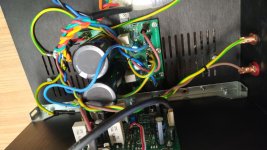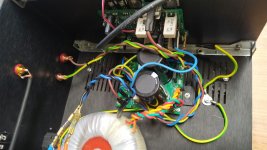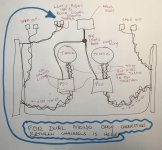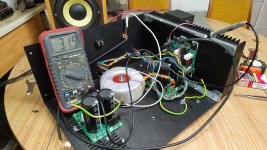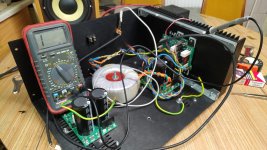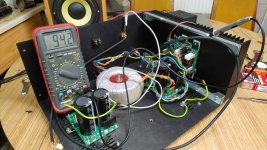No. Only if it is disconnected from the RCA, point 1 is correct.
hums when an input is connected. one or the other or together.It is not an interchannel loop.
Silence is only when the inputs are disconnected.
hums when an input is connected. one or the other or together.It is not an interchannel loop.
Silence is only when the inputs are disconnected.
Ok that definitely sounds like an earth loop. What other source equipment have you got? Can you try it with a preamp or CD player directly into the amp?
The reason your Bluetooth is quiet is because there is no earth loop. The electronics is floating wrt earth.
The reason your Bluetooth is quiet is because there is no earth loop. The electronics is floating wrt earth.
I use it directly from cd player .Yes, I also have a preamp .
Bluetooth- I know I just tried
I tried another CD player and DAC -Cambridge audio
Bluetooth- I know I just tried
I tried another CD player and DAC -Cambridge audio
Last edited:
Strange..
-Did you measure resistance from signal ground to protective earth on the amp (not powered)
- With source and amp powered, but RCA disconnected, if you measure AC voltage between source signal gnd and amp signal gnd, what do you get? (current is more interesting, but voltage is easy to measure)
-Try reversing the polarity of the AC plug on amp or source (not both) and measure that voltage again.
All with one mono channel.
-Did you measure resistance from signal ground to protective earth on the amp (not powered)
- With source and amp powered, but RCA disconnected, if you measure AC voltage between source signal gnd and amp signal gnd, what do you get? (current is more interesting, but voltage is easy to measure)
-Try reversing the polarity of the AC plug on amp or source (not both) and measure that voltage again.
All with one mono channel.
For dual mono, there should only be one connection between the channels and that is right at the input connectors. In this way you ensure no internal ground loops and no cross channel ground loops.
I have never built a dual mono, but in theory it should be as quiet as a standard design. I would recommend you use the ground lifter - again this will ensure no connection to the
chassis below c. +-1.2V.
Best thing is to start from the beginning and wire everything up step by step. Building a quiet amp is a challenge and it does take practice (I am still learning 😉 )
Please see below.
I have never built a dual mono, but in theory it should be as quiet as a standard design. I would recommend you use the ground lifter - again this will ensure no connection to the
chassis below c. +-1.2V.
Best thing is to start from the beginning and wire everything up step by step. Building a quiet amp is a challenge and it does take practice (I am still learning 😉 )
Please see below.
Attachments
Rallyfinnen, I have done quite some sims and measurements on adding your cap to the bias controller.
Indeed, there is a very big improvement in distortion especially at LF. I will post some results later today.
Indeed, there is a very big improvement in distortion especially at LF. I will post some results later today.
Strange..
-Did you measure resistance from signal ground to protective earth on the amp (not powered)
- With source and amp powered, but RCA disconnected, if you measure AC voltage between source signal gnd and amp signal gnd, what do you get? (current is more interesting, but voltage is easy to measure)
-Try reversing the polarity of the AC plug on amp or source (not both) and measure that voltage again.
All with one mono channel.
This is a good start to solving the issue. Indeed, try to get the one channel hum free first.
Rallyfinnen, I have done quite some sims and measurements on adding your cap to the bias controller.
Indeed, there is a very big improvement in distortion especially at LF. I will post some results later today.
Great!
Actually I have not even tried the amp without it. Interested in getting your (subjective) impression if you add it to your amp.
I do love the bass my amp is putting out. I have not heard an amp with such good bass control without harshness in the higher registers. In my previous experiences it has been either one or the other. This strikes a good balance. This is why my priorities have been towards low PS impedance, but since I have not tried ripple eaters on the power stages, I don't know if it actually matters..
(I'm a sucker for good bass control, getting the right drum and bass sounds)
Last edited:
Another feature is that the caps ramps up the idle current nicely at power on. I used 220u on mine, and there is a couple of seconds delay on the idle current, so the amp is started up really 'gently' 🙂
Last edited:
I don't understand how you measured..? Voltage from RCA ground to safety ground? Seems like high voltages though..
-Measure between source and amp signal grounds with RCA disconnected (RCA ground on source to RCA ground on amp) with both powered on.
-Try switching polarity on one power plug and measure again.
-With amp totally disconnected, measure resistance from signal ground to safety ground on the amp. You can do this on the source too if it has a safety ground AC plug.
Seems like a case of high transformer leakage I think
-Measure between source and amp signal grounds with RCA disconnected (RCA ground on source to RCA ground on amp) with both powered on.
-Try switching polarity on one power plug and measure again.
-With amp totally disconnected, measure resistance from signal ground to safety ground on the amp. You can do this on the source too if it has a safety ground AC plug.
Seems like a case of high transformer leakage I think
Last edited:
23. februara 2021 - YouTube
I unplugged the cd player .
Rallyfinnen -yes I understood .
I'm not alone who has 90V AC.
I unplugged the cd player .
Rallyfinnen -yes I understood .
I'm not alone who has 90V AC.
Last edited:
GND and RCA 0ohm
It should not be 0 Ohm. Without ground lifter connected it should be open. With ground lifter it should be HBR + ground lifter resistor, 33+10(?) ohm. You need to find the short between safety ground and signal ground and remove it.
Is the RCA connector on the amp screwed to the case so the ground is connected there?
EDIT: Looking at the picture it looks like open circuit when you measure resistance to ground and have jut a 1 . on the meter? It should be 0.0 if it's a short? The other measurements, again I don't know what you are measuring?
Last edited:
Here is my write-up on the kx-Amp LF performance
'Rallyfinnen capacitor', I'm flattered 🙂 However, my real name is actually Sam, not Andreas 😉
BTW, maybe it would be good to update the original document with the stability and bias upgrades, easier for new builders to get the whole picture without reading through this tread?
Last edited:
- Home
- Amplifiers
- Solid State
- Hifisonix kx-Amplifier


